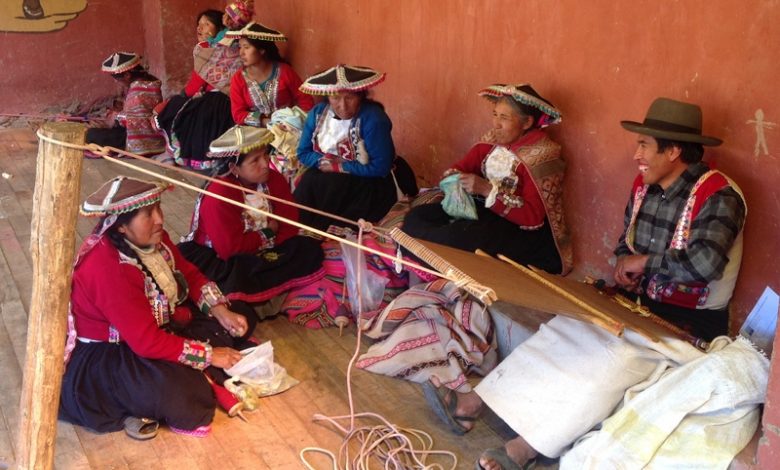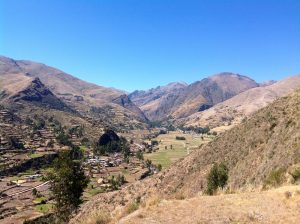Drinking and Eating at a Wedding in Pitumarka

One Saturday afternoon, Don Timoteo and I are sitting in the Pitumarka town square. A man is in his fifties, slim, athletic and of short stature approaches us. His asiatic features are bronzed and wrinkled from a lifetime of working in the sun.
He is wearing the red jacket, black flannel pants, a poncho and a fedora Pitumarkan men have worn for centuries. This traditional dress is modeled after sixteenth-century Andalusian Spain. Andean Ponchos are a syncretism of Ponchos of the Cowboys from rainy Northern Spain and the traditional Andean tunic called uncu. Andean ponchos are no longer stitched along the sides allowing the front and back panel to move more freely.
The man pays his respects and speaks to Don Timoteo in Quechua. He politely requests our attendance at his daughter’s wedding taking place the next day. The bride is a member of the Pitumarka weaving community and lives in the next village above Pitumarka, Wasapampa, where the wedding will be held. Shortly after, the bride and groom approach us asking us if we could attend their wedding. Again, Don Timoteo agrees.
The next day, Don Timoteo explains that if we do attend the wedding, we are expected to donate a reasonable amount of cash to the newlyweds or bring gifts in the form of kitchen items, bags of produce, sugar or coca. In all likelihood our hosts will insist we stay as long as possible, feasting and drinking and delaying our return to Cusco. Curious about the wedding and aware of Don Timoteo’s commitment, I agree to accompany him. In preparation, we wash our faces in the outdoor sink, put on our ponchos and take a mini bus full of other wedding guests on the short, bumpy ride up to Wasapampa.
When we arrive at the village, we cross a bridge over the pristine Ausangate river. Its banks are covered with pampas grass and beautiful cantu bushes, with their long, slender trumpet-shaped flowers of red or yellow are an icon for the Peruvian Andes. As we approach the village, we hear loud speakers set on a huge stage blaring Andean music. The stage is located on a large field along the road side facing the newlywed’s tent. Hundreds of guests are sitting or standing along opposite sides of the field in between the stage and tent and is reserved for dancing and rituals. As we enter the newlywed’s tent and are warmly greeted with Andean style hugs, first by the newlywed’s parents, the groom and then by the bride. We approach the exchange table and give our donations. The announcer then declares our names on the loudspeaker as well as how much cash we donated.


As we leave the tent we are offered terra cotta cups filled with special chicha (mild corn beer) and a bowl full of barley gruel. But this is only the beginning. As we sit on a berm with Don Timoteo’s cronies, young men from the community offer shots of liquor and distribute huge bottles of “Brahma” beer and another bowl overflowing with special meats and chuño (freeze-dried potatoes). We are obliged to accept or offend our hosts. Throughout the afternoon and into he evening, more food and drink arrive from family and guests and although we politely decline, it is taken as politeness and insist we accept. Drinks and plates of food accumulate and still our hosts insist we take more. We try another strategy by offering others our food and drink but kindly reciprocate by supplying us with even more food and drink than we gave away.
Ritual feasting, public drunkenness, even vomiting, especially among older members of the community are common at fiestas, marriages. I delighted in watching the father of the bride, silly drunk, twirling in place with a huge grin on his face and two large bottles of beer in each hand, his poncho flying about as if he could fly away. I see an elderly couple dancing in the compound hand in hand who are so drunk they keep falling to the ground who struggle to get up again. Such displays are only tolerated among older members of the community.
Don Timoteo’s status is obvious with the deference they bestow on him. Countless relatives, compadres, comadres and god children pay their respects — it is good that we came. I also meet Don Timoteo’s former chauffeur and body guard when Don Timoteo was the mayor of Pitumarka. A delightful man, though not to be toyed with.
As night falls, the stack of bagged produce and kitchen utensils and other gifts brought by the grooms family is accumulating into a huge mound. Women from the bride’s family form a semi-circle and gifts are formally redistributed by men from the groom’s family. Each item is accounted for and the grand total is announced over the loud-speaker. The items are then carried off to the newlywed’s house?.
Needing to urinate yet again, I walk towards the designated field but instead I am escorted into the newlywed’s tent and made to sit next to the bride and groom, the mayoral candidate for Ptumarka, select guests, serving me more food an chicha. I finally make my way to the bathroom (field) and return to the spot where I last saw Don Timoteo. I see my plates of food and drink and chicha cup. I ask for Don Timoteo. Naturally, he is nowhere to be found, attending yet another feast inside one of the numerous houses within the community. I begin to feel more and more nauseous and decide to make my escape to Pitumarka. Fortunately, there is an enterprising young man who is willing to take me down the hill for only five Soles (Peruvian currency). Sitting on the back of the motorcycle, the chill night air revives me. When I arrive at the Ccarita family compound in Pitumarka, The family asks me what happened to “Papa Timo”. I have no answer.




